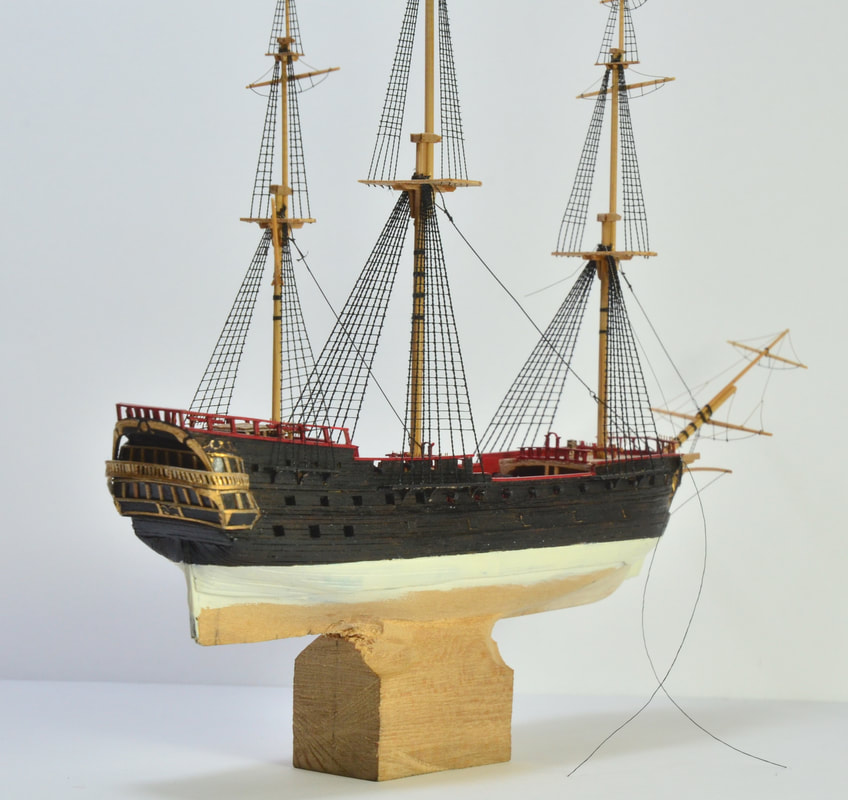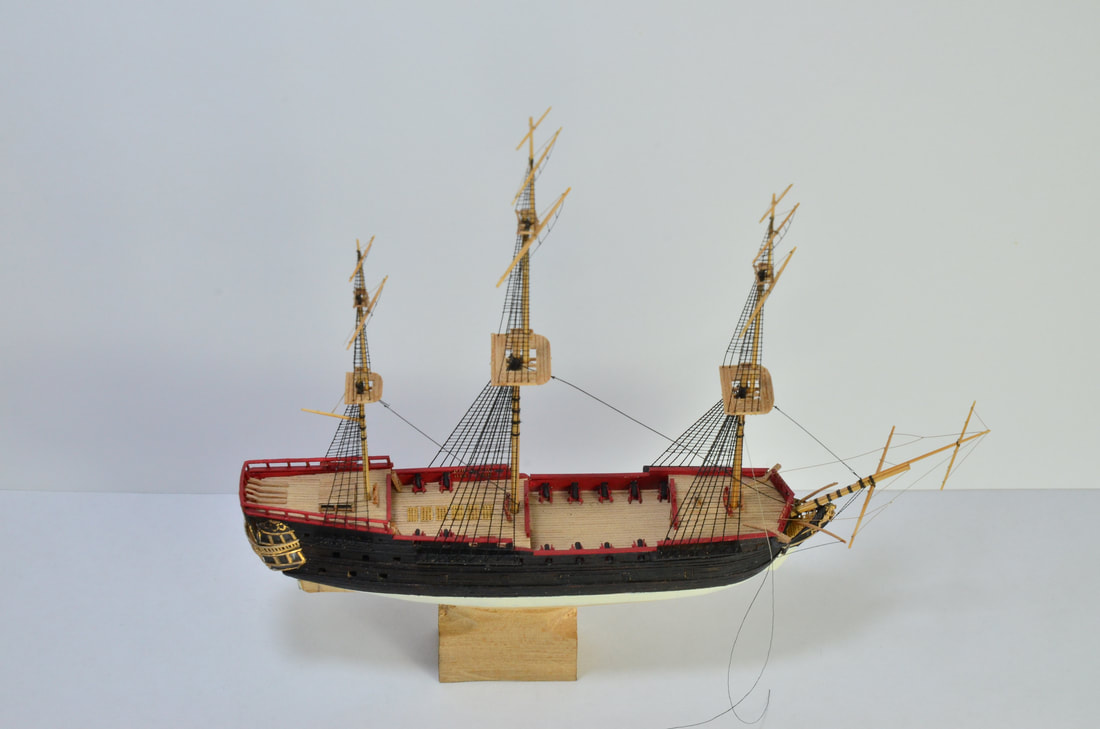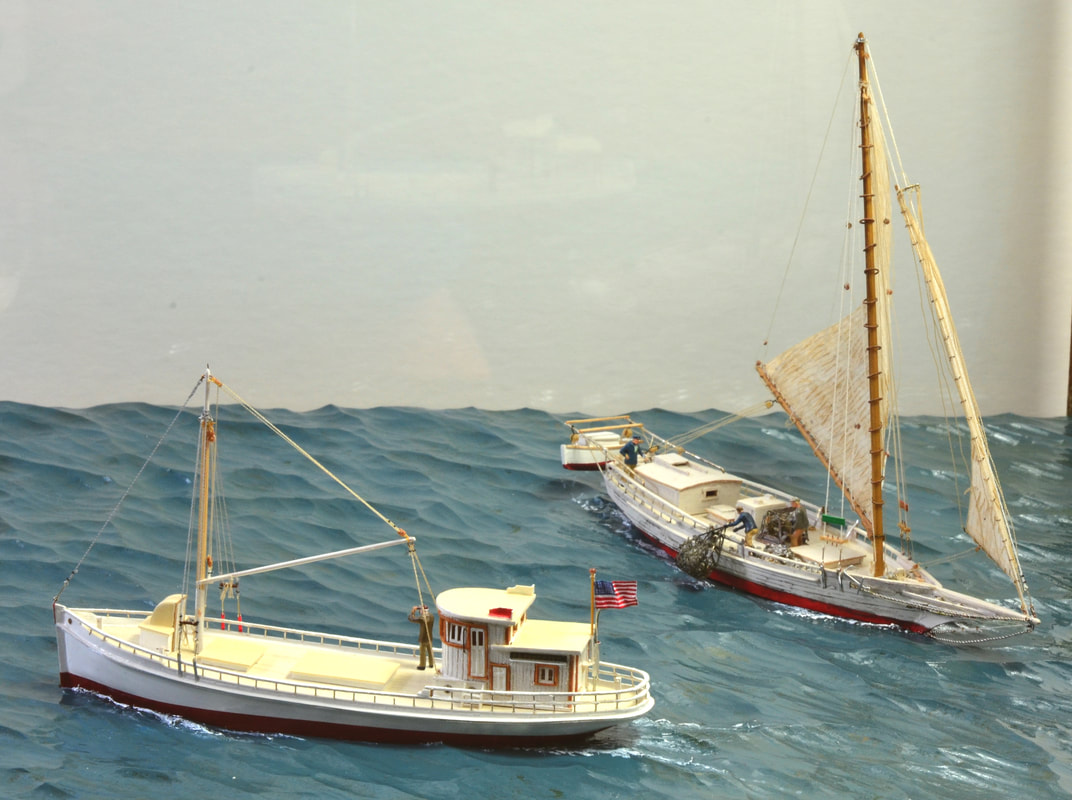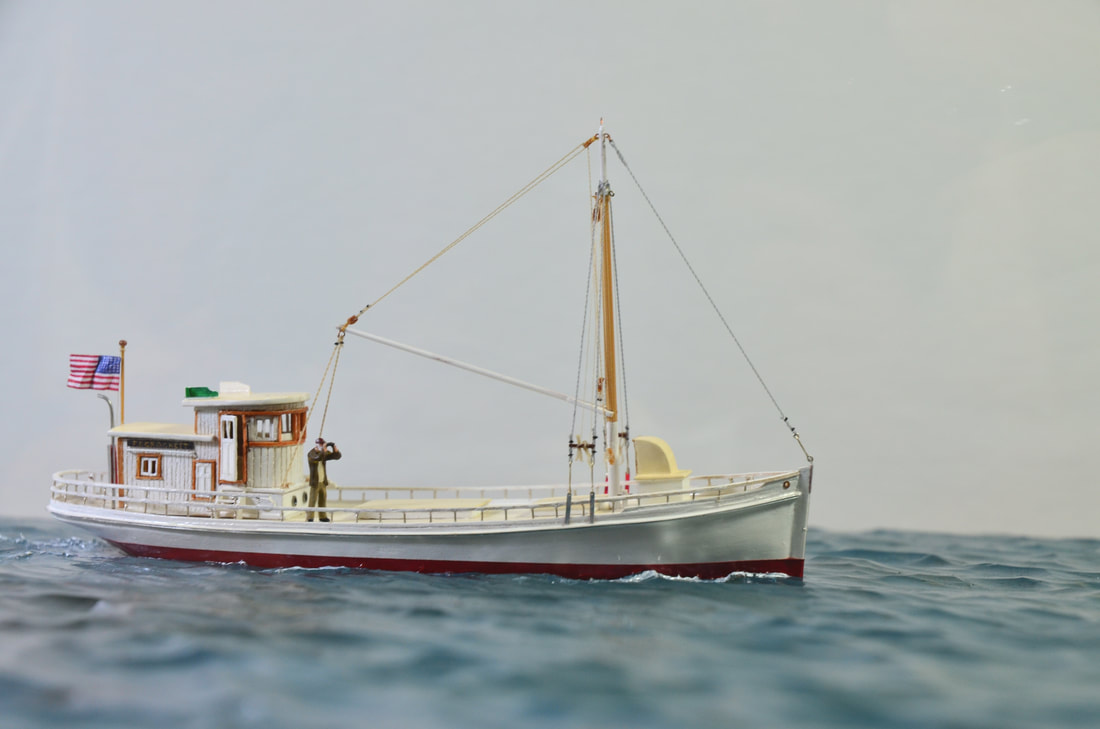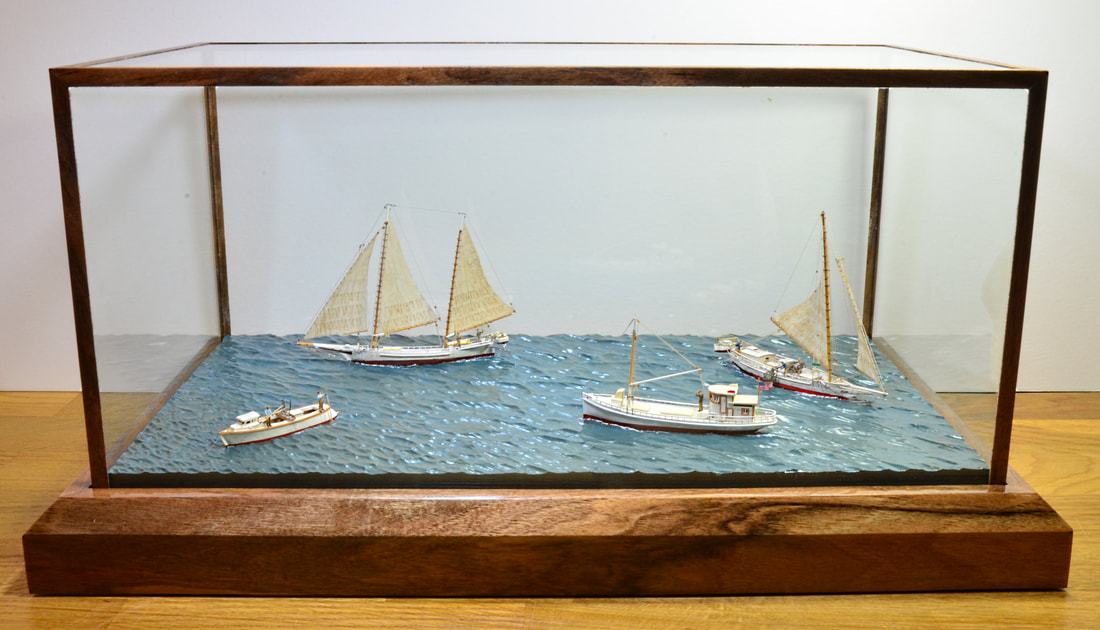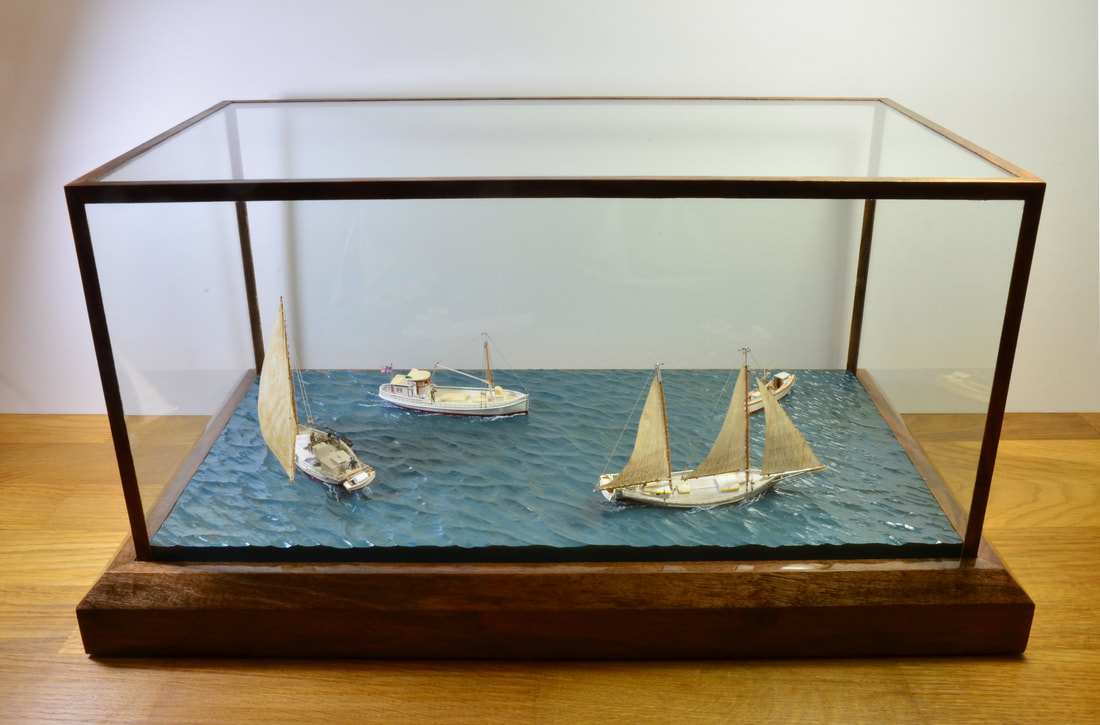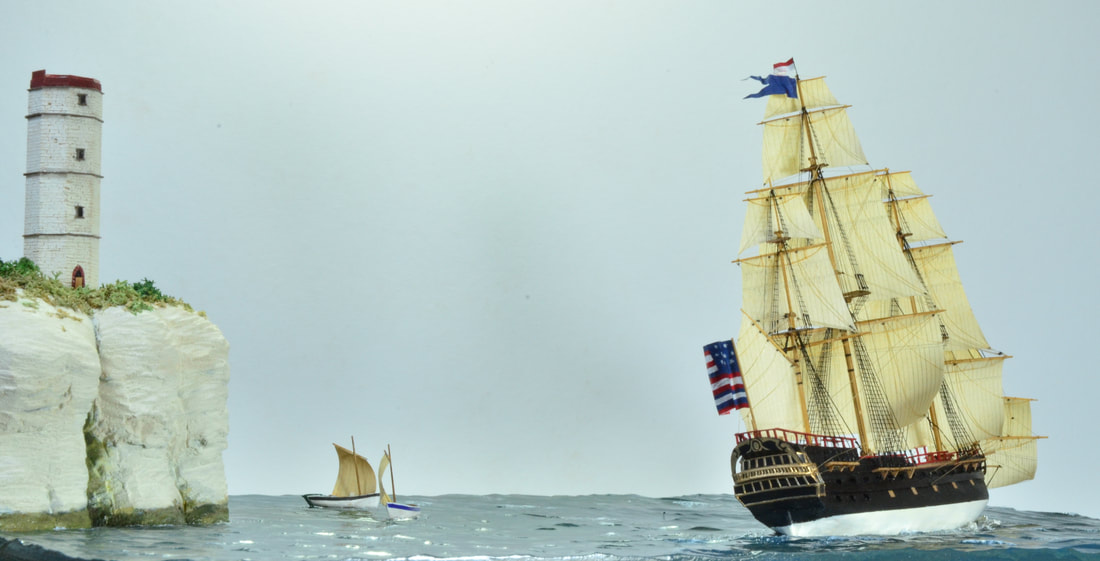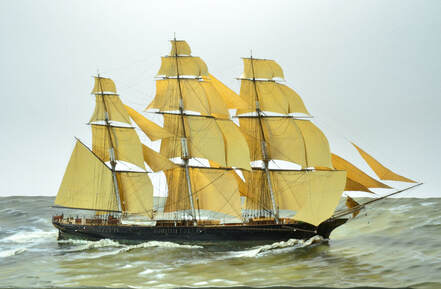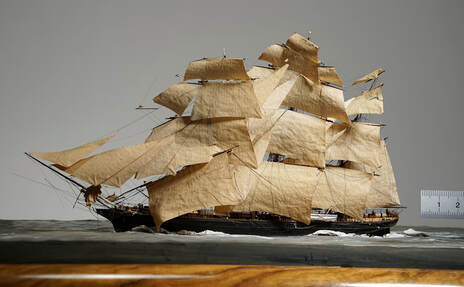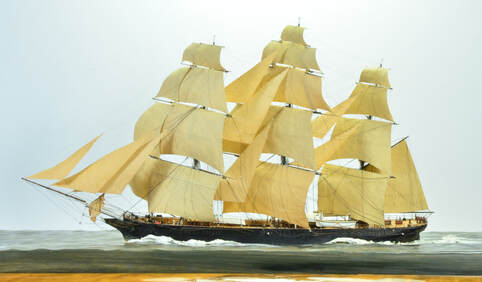Miniature Case Models:
Gabrielle also builds miniature ship models in glass cases. These models are completely hand crafted, highly detailed miniatures displayed as waterline dioramas or free standing models.
Waterline Diorama of the Whaling Bark Sunbeam 1856 Whaling in the Arctic Scale 1:160 (1" = 14') - Contact me for availability
The Sunbeam model is a planked over solid hull construction, with laid decking. She is authentically painted with accurate deck furniture, rigging lines, and equipment for her set of sails. Multi-strand cord was fabricated to accurately depict the rigging lines at scale, and the sails are made of archival bible-paper. The model was built based on 5 plans by Walter E. Channing, Clifford Ashley’s book The Yankee Whaler, as well as Ashley’s photographic record of his voyage aboard Sunbeam in 1904 from the book Sperm Whaling from New Bedford by Elton W. Hall. The diorama contains four outfitted whaleboats, with two stowed spares, built by planking over a miniature frame. There are 31 active crew members, made from manipulated and painted figurines, present throughout the diorama. The hand carved wooden sea is set in a walnut veneered case base.
Sunbeam is displayed hove to with some sails furled and lowered, in an Arctic seascape in the presence of icebergs. Three whaleboats are hunting bowhead whales, two towing a whale to the ship, and one chasing under sail. The crew on board are working from the cutting stage to cut-in a whale, manage the windlass and cutting-in tackle, process the blubber into oil at the tryworks, and complete other tasks.
A note to my visitors: This diorama is not a celebration of our whaling history, but a realization of the impact we've made on the natural world. I am a lover of the sea, a sailor myself who has witnessed the beauty of whales in the Atlantic from my own sailboat. I do what I can in my private life to promote biodiversity and the protection of the natural world, and keep my footprint small. - Gabrielle Rogers
Please read my artist's statement below:
Please read my artist's statement below:
Your browser does not support viewing this document. Click here to download the document.
Stormy Weather 1934 Scale 1:96 (1/8"=1") - SOLD on Commission
|
The model measures 18.5cm long (7.25 inches) from bumpkin to bow. She is a hand-carved, solid hull construction with laid deck slats of Alaskan cedar and a king plank in cherry wood. Her cabins, hatches, skylights, and cap rail are also made of cherry.
The miniature winches and belaying pins were turned from brass on a lathe. Each turnbuckle was made from the eye of a needle with metal ringlets fixed to each end (that was a task to figure out and complete!). The blocks and pulley are all functional in that the line passes through them and can be pulled tight and tied off to a cleat. She is depicted with original upper and lower set of running backstays and her winches are in their original positions. She is displayed on a spruce plinth fixed to the wooden base, which is veneered with European walnut. |
Designed by Olin Stephens of Sparkman & Stephens when he was only 25 years old, Stormy Weather is one of he most elegant classic yachts to still graces our waters today. She was launched in 1934 from the Henry B. Nevins Yard in New York, and has had an impressive career, winning some of the most notable races including the 1935 Transatlantic race, the 1935 Fastnet race, the Miami Nassau race five times between 1937 to 1941, and still to this day participates in the classic yacht regattas on the Mediterranean.
This model was built from the plans and information in "Uffa Fox's Second Book" as well as historic images and documents. |
Under Construction:
USS Bonhomme Richard 1765 Scale 1:432 (36' =1")
This model will be more detailed than the last. Her hull is carved from a solid block of wood planked over with pear wood and the deck planks are maple. I fabricated stranded cord from fly tying line and the rest of her rigging is either copper or nickel chromium wire. Here masts and yards are bamboo and miniature canons were turned down from boxwood. She will ultimately be displayed sailing alone as a waterline model on a hand-carved, wooden sea.
USS Bonhomme Richard 1765 Scale 1:432 (36' =1")
This model will be more detailed than the last. Her hull is carved from a solid block of wood planked over with pear wood and the deck planks are maple. I fabricated stranded cord from fly tying line and the rest of her rigging is either copper or nickel chromium wire. Here masts and yards are bamboo and miniature canons were turned down from boxwood. She will ultimately be displayed sailing alone as a waterline model on a hand-carved, wooden sea.
Workboats of the Chesapeake Bay - Circa 1930 Scale 1:170
Waterline Diorama in a Glass Case containing with the Skipjack E. C. Collier, the Bugeye Edna E. Lockwood, the Buyboat F. D. Crockett, and a Hooper Island Draketail.
AVAILABLE FOR PURCHASE: Contact for price
Waterline Diorama in a Glass Case containing with the Skipjack E. C. Collier, the Bugeye Edna E. Lockwood, the Buyboat F. D. Crockett, and a Hooper Island Draketail.
AVAILABLE FOR PURCHASE: Contact for price
|
|
The Story:
The Skipjack E. C. Collier is having a successful start to the day, dredging oysters under a light breeze beyond the shallows where the crew on the Hooper Island Draketail deadrise are hand tonging. The captain of the Buyboat F. D. Crockett looks on through his binoculars, waiting for the moment to collect a load of oysters, as the captain of the Bugeye Edna E. Lockwood greets the buyboat with a friendly wave as they head for harbor to pick up a load of lumber. The Historic Workboats of the Chesapeake Bay: Built in 1924, the F. D. Crockett is a 9 log-bottom built buyboat. She was completely restored and is currently maintained by project manager John England and his dedicated crew of volunteers at he Deltaville Maritime Museum. The Edna E. Lockwood was built in 1889 and is the last survivor of the log-hull bugeyes. Like the Crockett, her hull is made of 9 logs. The boat has been lovingly cared for and gone through multiple restorations by the Chesapeake Bay Maritime Museum in St. Micheals, Maryland, where she is maintained in sailing condition. The Skipjack E. C. Collier was built in 1910 and is a permanent exhibit at the Chesapeake Bay Maritime Museum in Maryland. The Hooper Island Draketail is a deadrise built Chesapeake Bay workboat, given its name because of its lovely reversed, round transom. |
Pemaquid Friendship Sloop Scale 1:72
Available for purchase - Contact for price
Available for purchase - Contact for price
USS Bonhomme Richard Passing Flamborough Head Chalk Cliffs:
SOLD on commission
SOLD on commission
|
The USS Bonhomme Richard, captained by John Paul Jones, is displayed passing the chalk tower at Flamborough Head where in September of 1779 she engaged in battle with the British and forced the surrender of the HMS Serapis. Upon request by the commander of the Serapis for Jones to surrender, he responded with his famous line, "Sir, I have not yet begun to fight!" The hull is of solid, carved basswood construction, with a maple planked deck, and plum wood strakes. The canons are boxwood. The masts are of turned bamboo and sails are 60 grams archival bible paper. Rigging lines are a mixture of fly tying thread and wire, with blocks and deadeyes present. The ship is sailing on a broad reach upon a basswood carved and painted sea. Two small fishing cobles sail near the Flamborough chalk cliffs, on top of which, sit the famous chalk tower built in 1669. The scene is set in a custom walnut veneered case with 4mm glass panes. Scale: 1:432 or 36'=1" |
Restoration of the Taeping by Donald McNarry:
Gabrielle had the pleasure of restoring the miniature waterline model of the Taeping, built in 1957 by McNarry. The scale of the model is 32'=1." The model had been seriously damaged with all masts broken in multiple locations, many spars broken, bent or, missing, almost all of the square sails and studding sails damaged with minute damage to some staysails, and a significant amount of running and standing rigging detached, broken, and deformed.
Gabrielle had the pleasure of restoring the miniature waterline model of the Taeping, built in 1957 by McNarry. The scale of the model is 32'=1." The model had been seriously damaged with all masts broken in multiple locations, many spars broken, bent or, missing, almost all of the square sails and studding sails damaged with minute damage to some staysails, and a significant amount of running and standing rigging detached, broken, and deformed.
To maintain the original integrity and spirit of the model, a lot of attention was invested in researching and understanding the methods and materials used by Donald McNarry, by observing images reading descriptions of his models, and studying his books. Equivalent glues and materials were used for any item on the model that had to be replaced, repositioned, or refinished, with some exceptions. All detached pieces of the model were recuperated and used in the restoration, while fine archival bible paper was used to replaced damaged sails, nickel chromium wire was used to replace portions of the rigging that was missing or damaged, enamel paint was used for retouching, and a completely new glass case with walnut veneer was fabricated. The sea was carefully cleaned and two coats of varnish applied.
The decision was made between the client and artist to thoroughly repair the model while at the same time keeping all of the original materials as possible. Thus, the model was not disassembled and completely restored, but fixed as best as possible in place. Some adjusting to rigging lines was made with the objective that they lay more naturally (though not always possible), and only missing portions of the model were replaced with new materials.
The decision was made between the client and artist to thoroughly repair the model while at the same time keeping all of the original materials as possible. Thus, the model was not disassembled and completely restored, but fixed as best as possible in place. Some adjusting to rigging lines was made with the objective that they lay more naturally (though not always possible), and only missing portions of the model were replaced with new materials.















